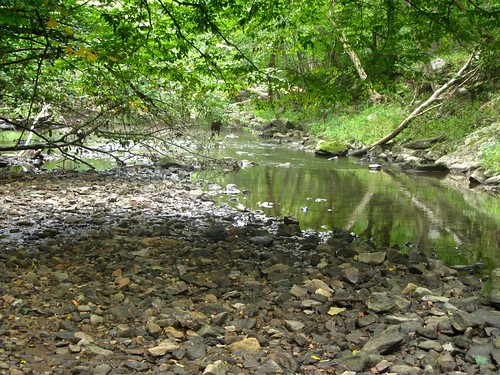Of Nightmares and Watersheds
Filed under: Environment, Global issues
“If gold has been prized because it is the most inert element, changeless and incorruptible, water is prized for the opposite reason — its fluidity, mobility, changeability that make it a necessity and a metaphor for life itself. To value gold over water is to value economy over ecology, that which can be locked up over that which connects all things.” ― Rebecca Solnit
The nightmare that comes to me while I sleep always begins the same way. I am standing next to Colesville Road in Silver Spring, Maryland, near where Northwest Branch creek crosses this highway.
But instead of the small filtration station that once served the modest-sized dam a couple of hundred yards upstream, there is massive hi-rise development everywhere: acres of uber-modern condos and swanky shops cover the ground where I once pried off samples of translucent mica from the soft sandstone in the forest above the creek.
In the nightmare, the stream valley on both sides of the highway, once crowded with ancient trees, has been denuded and the resulting silt has turned the once clear waters a sluggish brown. The boulders and small waterfalls downstream are still there, but bake in the sun instead of being protected by the cool shade of an Eastern forest.
When I to hike down the creekside trail, it never leads to the house I once called home. I become lost amidst unfamiliar boulders and side trails that lead nowhere. When I awake I am filled with a deep and terrible sadness. This is a recurring nightmare of mine. It comes upon me frequently.
During my teen years I explored that publicly owned stream valley for miles in both directions, often hiking through the water in an old pair of tennis shoes. I came to know the sucker fish who swam in the shallows, the tadpoles of the vernal pools and the box turtles who would seek relief from the summer heat in the calm areas of small feeder streams.
Fallen logs across the creek provided easy bridges to the old suburb of Woodmoor, high on the other side of the valley, where the branch library kept me furnished with a steady supply of science and science fiction books.
In the winter, the half-frozen waterfalls became an ever-changing sculpture garden of icy surrealism.

Northwest Branch north of the small dam
Teddy Roosevelt visited Northwest Branch in 1904 and wrote to his son: ” … there is a beautiful gorge, deep and narrow, with great boulders and even cliffs. Excepting Great Falls, it is the most beautiful place around here.”
Northwest Branch crosses the geological fall line between the Piedmont and Atlantic coastal plain regions which explains the small waterfalls south of Colesville Road.
Rachel Carson’s former home where she wrote much of “Silent Spring” is near Northwest Branch. The trail there is now called the Rachel Carson Greenway. Famed photographer Alfred Eisenstaedt photographed her near the creek for a 1962 Life Magazine article.
Although the stream quality has been adversely affected by storm water runoff from the crowded suburbs that surround it, it is afforded some protection by government agencies of Montgomery and Prince Georges County. The Neighbors of Northwest Branch organization leads nature walks there and monitors its condition.

Rachel Carson birdwatching along Northwest Branch
So why do I have recurring nightmares about Northwest Branch instead of recurring dreams of its beauty, a beauty that has largely survived since the end of the last Ice Age?
Why? Perhaps because Northwest Branch is a part of the Anacostia watershed.
It empties into the dangerously polluted Anacostia River which flows past Southeast DC, a largely African American working class community. Much of the pollution comes from suburbs upstream or from the rest of DC across the river. A short distance away, across the bridges that span the river, are the EPA headquarters and the Congress that passed the Clean Water Act.
According to the National Resources Defense Council: “Toilets in the Capitol regularly flush directly into the Anacostia — our federal government needs to show leadership and contribute its fair share to cleaning up the District’s rivers.”
Apparently Congress really does give a shit about our watersheds. That contrast alone is almost too much to bear, even as citizens groups and official agencies work to slowly repair the Anacostia River.
But in the face of greed and misplaced priorities, official agencies and well intentioned citizens groups are an easily breached line of defense. Powerful financial interests do it all the time.
So despite its present status as public parkland, the eco-system of Northwest Branch remains vulnerable.
But perhaps these nightmares about a favorite creek also stem from other places as well. Three women I’ve met are in a Michigan jail for non-violently protesting an Enbridge company pipeline that would carry Canadian tar sands oil across the Midwest. Tar sands oil is one of the dirtiest petro-products ever.
In 2010 leakage from an Enbridge pipeline caused the largest inland oil disaster in US history when it polluted Michigan’s Kalamazoo River.
In both West Virginia and North Carolina, energy companies recently leaked toxins into rivers with seeming impunity. In Northern Alberta where oil and gas development has ravaged the traditional lands of the Cree peoples, Melina Laboucan-Massimo said this:
“My community has dealt with three decades of massive oil and gas development. And this has been without the consent of the people or without the recognition of protection of the human rights which should be protected under section 35 of the Canadian constitution, which protects aboriginal and treaty rights.”
It is the reckless burning of coal, oil and gas that is accelerating climate change, drastically altering the hydrology of the entire biosphere.
Meanwhile, the snowpack of the High Sierras in California shrinks as climate change sweeps across the planet. What will become of those frigid fast flowing mountain streams whose waters I drank and whose rushing sounds lulled me to sleep as I camped near their banks.
And how many Californians depend upon that snow pack for their home water supply?
The UN tells us that,” More than 2.7 billion people will face severe shortages of fresh water by 2025 if the world keeps consuming water at today’s rates…”
I can’t be the only person who is having nightmares about fresh water, the lifeblood for terrestrial beings. My prehistoric Scottish ancestors once designated pools, springs and other water sources as sacred places of worship, as did other peoples around the planet.
But as social critic Karl Marx wrote,”… all that is holy is profaned, and man is at last compelled to face with sober senses, his real conditions of life, and his relations with his kind.”
I believe in neither gods nor goddesses. But the next time I visit Northwest Branch, my own personal shrine to water, I will offer a silent prayer.
May we please make water sacred again?

A small waterfall along Northwest Branch
A socialist since he was a child, Bob “BobboSphere” Simpson is a retired history teacher now living in Oak Park IL.
Sources Consulted
Neighbors of Northwest Branch
Rachel Carson Greenway & Northwest Branch Stream Valley Park Trails
Northwest Branch Subwatershed Action Plan
Robert B. Morse Water Filtration Plant
Cleaning Up the Anacostia River by the National Resources Defense Council
Michigan Coalition Against Tar Sands
Report Warns Of Severe Water Shortages By 2025
Education Apartheid: A West Side Chicago Story
Filed under: Education, Race and gender, Society and Economy
“The massive school closings that have been part of CPS’s broader strategy dating back to the 1990s have drastic consequences: they tear apart school communities, disrupt deep and strong relationships between students, parents, and teachers, and dismantle organizations which are often students’ only centers of stability and safety.”—The Black and White of Education in Chicago
Chicago’s historically working class West Side has never been an easy place. Because of its concentration of poverty, the struggle for survival has always been part of daily life. The West Side has also been a center of social activism: From the Haymarket martyrs, to the Jane Addams-led Hull House, to today’s anti-poverty activists of Action Now!
Despite growing gentrification on the traditionally segregated West Side, most of the area remains majority Black and Latino. In 2013 quality education became a battleground as the Chicago Board of Education closed 50 schools, most of them in Black and Latino neighborhoods.
Over the past 3 months I attended meetings on the West Side about what to do in the wake of the closings. These discussions quickly expanded into topics like charter school proliferation, testing abuse, gentrification, scripted curricula, the school to prison pipeline, and Common Core. Expert speakers presented solid data as a basis for future action.

Valerie Leonard of the Lawndale Alliance noted that,”The West Side has really taken a disproportionate hit. The West Side has 17% of the [Chicago] schools, but we have absorbed 47% of the loss.” Chicago’s West Side was clearly a a major target in the war against public education. Read more


